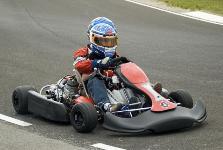 The main obstacle to driving a go kart is getting that spinning motion of the engine into useful spinning motion of the wheels.
The main obstacle to driving a go kart is getting that spinning motion of the engine into useful spinning motion of the wheels.
There are a couple of things to keep in mind when dealing with this transfer of motion though:
-Engines run continuously: go karts do not
-Engines cannot have a load suddenly dropped on them, they need a gradual engagement
-Engines do not have enough torque by themselves to just drive a wheel, a ratio reduction is required to get the torque level at the wheels so it is manageable by the engine.
-The go kart must stop, while the engine is still running
To get the power from the engine to the wheels a connection is required. This connection can come in a whole wide variety of forms:
-Belts
-Chains
-Belt and Chain Combinations
-Drive shaft
The most common drive system is the centrifugal clutch-chain-main drive sprocket layout.
This in and of itself is a form of transmission. Typically the ratios range from 7:1 to 10:1. (This may be all Greek to you so let’s back up the truck.)
Torque
When an engine spins it develops a twisting force called torque. You have probably seen that a weed hacker will quickly succumb or bog down in high weeds, whereas in light grass it will easily cut the grass.
The way a weed hacker works is to use the string to slice through the grass. The slicing action requires a force or a pushing of the string through the grass blades. This slicing force is related to the length of the string. In fact if you have a long string the motor bogs down and the weed whacker will not slice through the grass as well.
A prompt reduction of the string length will make the motor spin faster and the string to work more effectively.
The reason for this is as was stated before: "slicing force is related to string length." The longer the string length the more force is required.
In mathematical terms this is expressed as a combination of force and length. And is described as Torque.
Torque = Force x Radius
Another way you will recognize torque is when you are trying to loosen a very tight bolt.
When you put a long bar on the handle of the wrench all of sudden the bolt is a lot easier to remove. The amount of twisting force did not change, but the mechanical advantage did increase. The lever arm got larger, but the force remained the same.
Increasing the radius allowed you to use the same amount of force you were using before, but now all of a sudden the bolt came free. This is expressed in the following equations, torque 1 being the small handled wrench, and torque 2 the long handled wrench.
Torque 1 = Radius Short (6 inches) x 10 pounds = 60 in-lb
Torque 2 = Radius Long (12 inches) x 10 pounds = 120 in-lb
As you can see the torque level increase by 2 times. (Torque is expressed in terms of "inch-pounds" or abbreviated as "in-lbs."
Go Kart Drive Line
Similarly when you look at a sprocket chain connection you see that the chain is grabbing on to the teeth of the sprocket. This grabbing spot is located a certain distance from the centre of the sprocket. Say around 4 inches radius.
The sprocket for the clutch typically is very small, and has a diameter of typically around 1 inch.
The chain is grabbed by the clutch sprocket tooth and then transfers this grabbing motion as tension into the back sprocket, or the larger drive sprocket on the go kart axel.
The ratio between the small sprocket and the larger sprocket is related to the torque arms. The ratio is basically the large torque arm divided by the small torque arm:
Ratio = Large Sprocket (4 inches)/Small Sprocket (.5 inches)
Ratio = 8:1
This ratio is used in a couple of ways.
– First it is used to calculate the power required from the engine to the rear wheels.
– Secondly it determines how fast the go kart will go.
Translation:
– The amount of torque required at the rear wheels is 8 times what the engine can put out.
– Secondly the engine spins 8 times as fast as the rear wheels.
Typically a go kart weighing about 100 pounds with a 150 pounds person will scoot along pretty good on level ground.
When the go kart tries to go up hills that can be too much for the go kart, and will cause the engine to stall or make the clutch slip.
To get past this a system of changing ratios is needed. That is called a transmission.
There are various ways to address this changing ratio, with belt drives, transmissions or variable clutches.
To keep the go kart simple though (low cost) the most common system is the centrifugal clutch or one ratio system.
By Robert Gamble









Join the Discussion
Type out your comment here:
You must be logged in to post a comment.